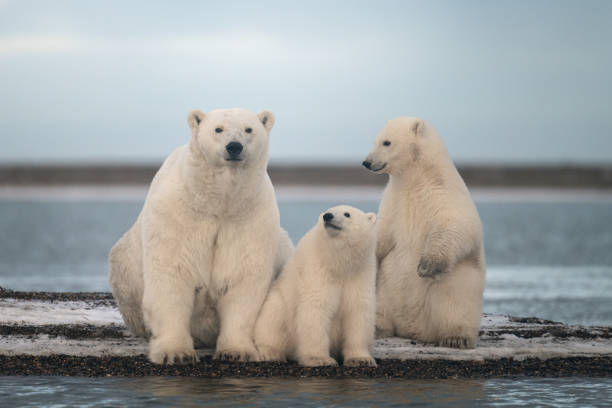What the devastating effects of the Willow Project will be
Polar bears in Kaktovik, Alaska, one of the species that could be harmed due to the Willow Project (Photo courtesy of gettyimage)
By Heyman Luong, staff writer
For the past few decades, global warming has been becoming an increasingly prevalent problem. With the consequences of glaciers and the poles melting and wildlife becoming extinct, temperatures are constantly driven higher by irresponsible emissions by countries around the world, and unless stopped, will inevitably lead to the death of the human race. Yet a highly controversial plan called the Willow Project was approved by President Joe Biden.
The Willow Project is a new oil drilling project in Alaska proposed by crude oil producer company ConocoPhillips, approved by the Biden administration on March 13. The project plans to create up to 199 oil drilling wells at three sites, being a multi-decade operation to mine millions of barrels of oil to make a profit, reduce gas prices and foreign oil dependency, and create additional jobs in Alaska—yet it is extremely controversial because of its projected environmental effects, and ultimately for going against Biden’s stated presidential goals. However, a condition of the deal was that ConocoPhillips had to give up rights to 68,000 acres of land in the National Petroleum Reserve-Alaska and have three sites instead of the proposed five.
Many climate activists and environmentalists are outraged by the plan, mainly because of its predicted emissions. Even just the three drilling sites would create “up to a third of the emissions created from all of the coal plants across the country,” according to an article on the website of Greenly, an organization that helps businesses track and reduce their carbon emissions. When running for president, Biden’s original policy was to stop oil drilling and reduce emissions, so approving a massive oil drilling plan seems entirely unreasonable. In one CNN debate, candidate Biden even stated that there would be “no more drilling on federal lands. No more drilling, including offshore. No ability for the oil industry to continue to drill, period.” And in 2020, President Biden’s administration announced that the U.S. would try to reduce emissions by 50%-52% of 2005 levels by 2030.
But the Willow Project directly conflicts with this.
In fact, it may be “next to impossible for the United States to achieve 50% of emission reductions by 2030” if the Willow Project is carried out, according to Greenly. A draft of the Willow Master Development Plan by the U.S. Department of the Interior Bureau of Land Management predicts that it could emit up to 287 million metric tons of carbon dioxide into the atmosphere over the next 30 years, causing up to $18 billion in damages to greenhouse gas emissions. This also works against the Paris Agreement, an international treaty on climate change adopted by the United Nations in 2015 to limit global warming to 1.5 degrees Celsius over pre-industrial levels.
Despite all the downfalls of the Willow project, many—including some indigenous groups—still support it. “The Willow Project is a new opportunity to ensure a viable future for our communities, creating generational economic stability for our people and advancing our self-determination,” said the president of the advocacy group Voice of the Arctic Iñupiat, Nagruk Harcharek, in a public statement. And it’s clear that Alaska needs a boost to its economy—US News and World Report in 2019 rated Alaska as having the worst economy of all 50 states. If indigenous tribes, who most likely know at least their land the best, say that the pros outweigh the cons, then it’s certainly worth considering.
Not only will the Willow project benefit many natives, but the project was also scaled back quite a bit to reduce environmental impact. Instead of the original plan of five drilling sites, it is now three, and the deal permanently conserves “millions of acres of sea and land,” according to Biden. Furthermore, the project is estimated to “create more than 2,000 construction jobs and 300 permanent jobs,” according to the US Bureau of Land Management.
Still, the natives and the city closest to the drilling site, the Nuiqsut, oppose the project. The City of Nuiqsut and Native Village of Nuiqsut even sent a letter to Interior Secretary Deb Haaland saying how the “public and cooperating agency process has been deeply flawed,” and that the Bureau of Land Management “must address the impacts of uncontrolled gas leaks” and “consider an alternative that protects [their] subsistence and traditional way of life.”
So is the Willow Project really justifiable? In 2021, the International Renewable Energy Agency estimated that the world would need to invest 131 trillion dollars into limiting global warming by 2050—and by increasing that already incredibly high number, we will only make things worse. Problems are only getting worse, and according to the U.S. Environmental Protection Agency, “Since the late 1970s… the United States has warmed faster than the global rate.” As a country, we have been irresponsible, and at some point, we must draw a line to slow down global warming. And the Biden administration isn’t stopping—in late March of this year, 73 million acres in the Gulf of Mexico were offered to be auctioned off for oil drilling, proving that the Willow project wasn’t a one-time thing.
With the Biden administration claiming that it would move forward with conservation efforts after the Willow project yet furthering the oil industry only a few weeks later, it becomes clear that the promises made will remain only words. And we need more than words to ensure our nation's and our world's viability in the future.

